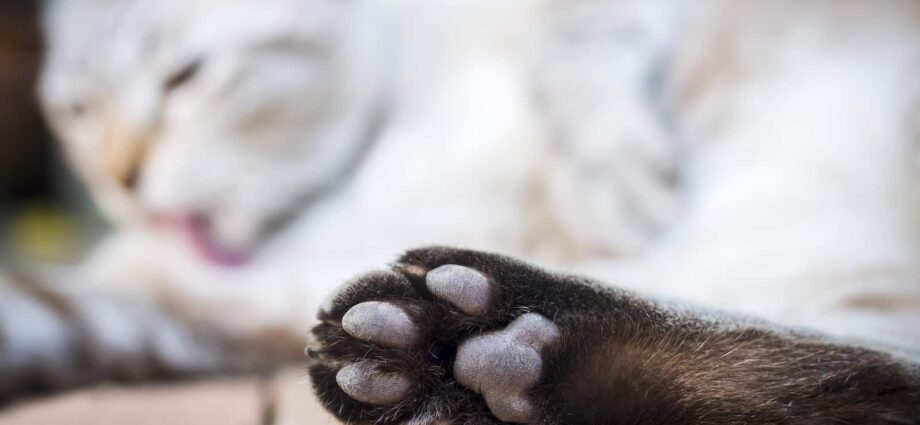Contents
Cat’s paws: how to take care of them?
An attack or injury to one of the cat’s paws can be painful and disabling. Therefore, taking good care of your cat’s paws is important for their health and well-being. In any case, if you have the slightest doubt, do not hesitate to contact your veterinarian.
The right gestures for the cat’s paws
Taking care of your cat’s paws involves taking care of its pads or maintaining its claws, but that’s not all. Indeed, there are many other good gestures to prevent certain attacks on his paws. The following points can be cited in particular:
- Wipe the paws: this is a gesture which may seem trivial but which is essential. Indeed, cats that go out can sneak and walk in various places, for example walking in substances that are harmful to them (such as gasoline) and then ingest these substances by licking their paws. Therefore, it is recommended to check your cat’s paws after each outing and to wipe them if they are wet or even to rinse them if necessary;
- Check the paws regularly: whether your cat lives outdoors or indoors, it may happen that he gets injured, cuts himself or even gets something stuck in the paw. Some cats express their pain very little, so you might not see your cat limp. Therefore, regular checking is important. Also be sure to clean the floor and surfaces if an object breaks, especially glass, so that no small debris gets lodged in one of its legs and causes an injury that can have serious complications;
- Pay attention to openings: it can sometimes happen that a cat gets a paw stuck in an opening (door, window, etc.). Thus, it is recommended to pay particular attention to potential openings where your cat’s paw could get stuck. It is important to provide a safe environment for your cat, who is an explorer animal. Remember not to give access to places where your cat might not be safe or else to arrange this space well so that there is no risk of injury for your cat;
- Having a scratching post: scratching is one of the cat’s essential needs. This activity is necessary for his well-being and his health. Thus, all cats must have a scratching post and / or a surface to make their claws. In addition to marking its territory by depositing pheromones, scratching is important for maintaining its claws but also for stretching and thus maintaining their muscles and joints.
In addition, it is recommended to get your cat used to being handled from an early age, in particular to having the paws handled, so that it is easier for you and for him afterwards.
osteoarthritis
Osteoarthritis is a syndrome (set of symptoms) that affects the joints, characterized by progressive degeneration of the articular cartilage, especially in the limbs. This condition is very painful. However, in general, cats express little pain. Osteoarthritis is therefore difficult to observe in cats. Older cats as well as overweight cats are more likely to be affected. Observable clinical signs are difficulty moving (jumping, exercising, etc.), reduced physical activity, stiffness, pain or even lameness. In addition, the time spent on the toilet can also be reduced and behavioral changes can be observed.
Prevention of osteoarthritis
Several actions can be taken to prevent the onset of osteoarthritis in cats, in particular regular physical exercise or even an adapted diet to preserve their optimal weight and prevent overweight. In addition, preventive solutions make it possible to prevent the appearance of joint disorders, in particular in elderly cats. Do not hesitate to discuss it with your veterinarian.
If you notice a lameness or excessive licking of a paw of your cat, you should consult your veterinarian.
What to do in case of injury ?
If you have a superficial paw wound, you can take care of it if you have the necessary equipment. First of all, it is essential to wash your hands well. Then, you can clean your cat’s wound with clean water and soap. Then disinfect the wound with a local antiseptic. Be careful to only use compresses. In fact, cotton is not recommended because the fibers it contains can be inserted into the wound. You can then put on a bandage, but it is best to leave the wound open. On the other hand, your cat should not lick itself. Disinfection is then to be carried out daily. On the other hand, if after a few days the wound does not heal, if it oozes or if pus is present, you must go to your veterinarian.
Be careful, as soon as the wound is too deep or very extensive, bleeds profusely or your cat seems ill, a veterinarian must take care of this injury. Likewise, you should see your veterinarian if the wound is in a joint.
In any case, if you have the slightest doubt, do not hesitate to contact your veterinarian who will be able to advise you and guide you on the procedure to follow.










